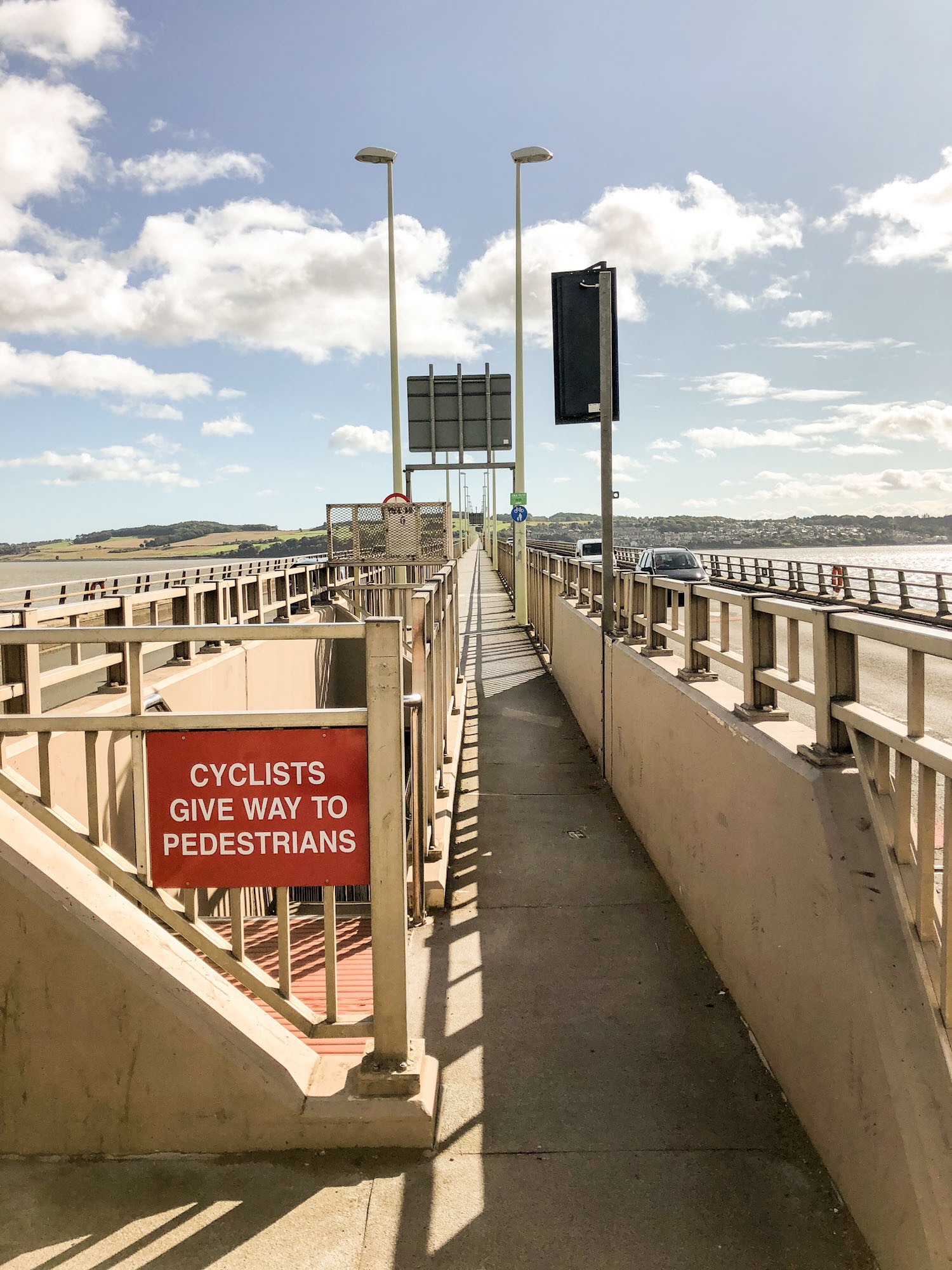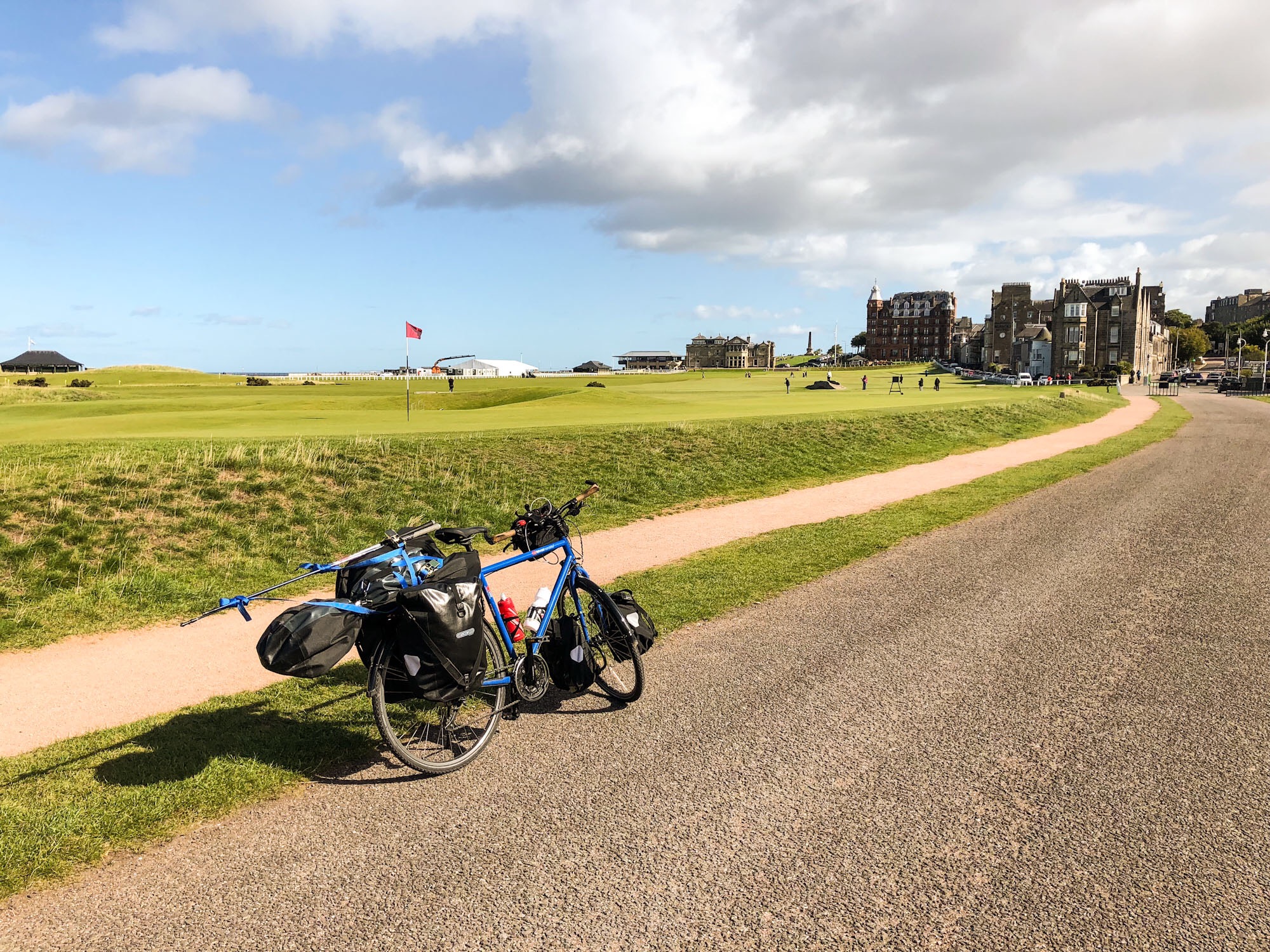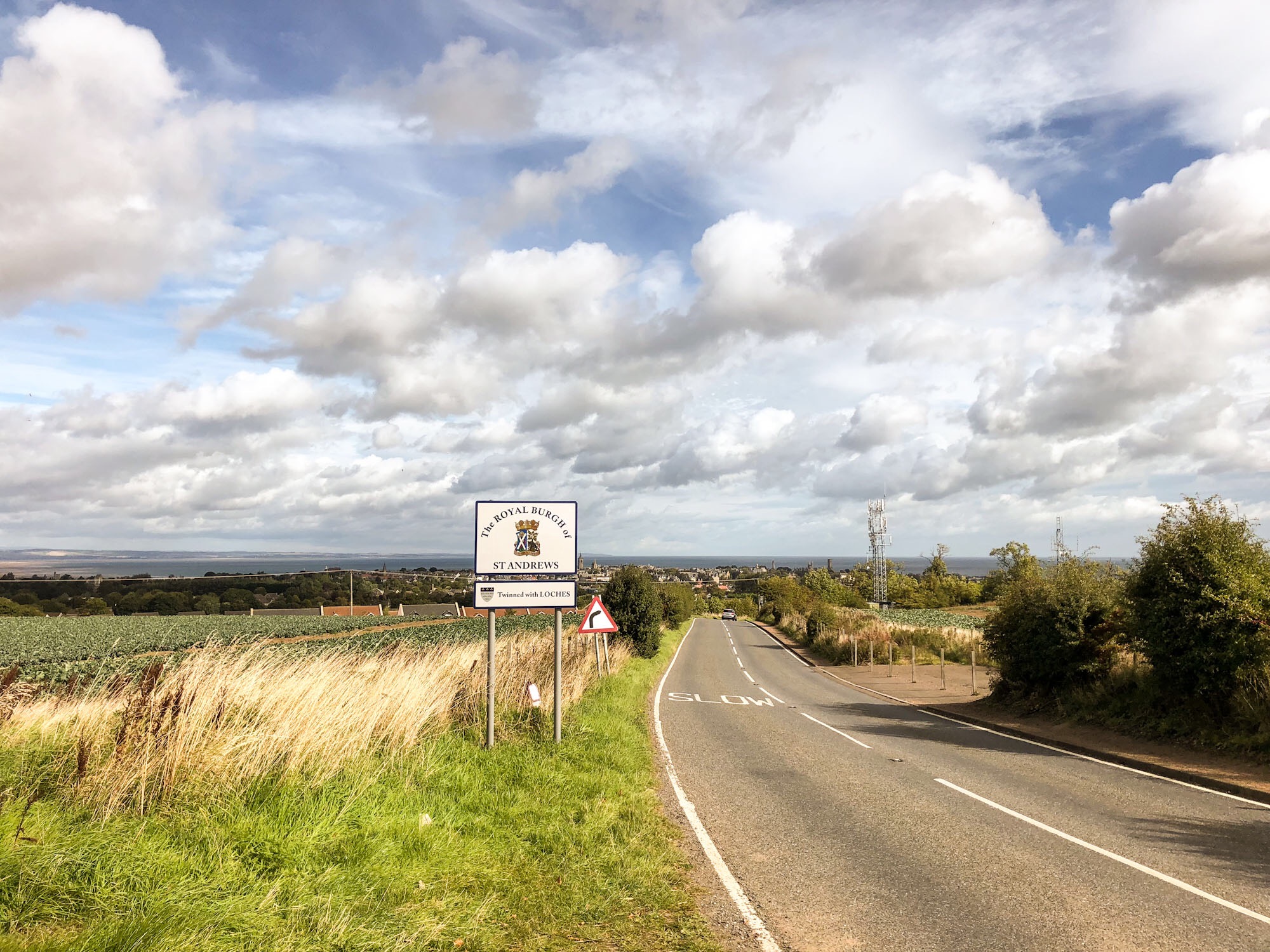If it doesn't work out again today, then I take a taxi for the rest of the way or ask a tandem driver to adopt me. Only 30 km separated me from St. Andrews, the birthplace of modern golf and the birthplace and deathplace of the godfather of the game: Old Tom Morris.
The wind was still strong, still coming from the same direction, but much weaker than the day before. Apart from that the sky was beautiful again. I had a lot of luck with the weather so far. Of course there was rain a few times, which also hit me occasionally when I was on the course or the track, but so far there was no enduring period of rain. I even experienced several hours of continuous rain only when I was in the tent anyway. That wasn't great, it took a little more effort to pack up the next day, but it was never enough for a drama.
So, I drove towards Dundee and could see the Tay Road Bridge, which would take me over the Firth of Tay from far away. But before that there was a relatively original part for cyclists to pass. The National Cycling Route 1 leads directly through the harbour area. But to get on this way, you have to pass the gatekeeper. But in this case this is not Sigourney Weaver and the keymaster does not have to be involved. Rather, the guard sits in a cottage that is approximately 50 metres away. The gentleman's gestures about the locking mechanism could read: a) Please come here (waving) and let me have a look at your ID (repeatedly pointing at his eyes), then I'll open the gate for you (pointing at the gate in front of which my bike is standing) or b) Please stay there, hold your ID in front of the camera and then I'll open the gate. I have chosen a). B) on the other hand would have been correct. The next time I want to cycle through the port of Dundee, I know that. Similarly tricky and equally solvable was the task at hand a few minutes later to find the way intended for cyclists over the bridge. There is a separate elevator, which - and this is really worth a special mention - was actually long enough to accommodate my entire overlong vehicle. Quite special and worth remembering was the path over the bridge: A long, straight bicycle path (okay, there could have been pedestrians there as well) in the middle between the lanes for motorized traffic. A very relaxed ride.

Afterwards it was a few kilometres less relaxed, as I had to share the relatively narrow road with an above-average amount of cargo traffic. But then I approached the golfing heaven. I knew from earlier visits that I had to be careful to find the direct way to the world-famous Road Hole. In fact, only a footpath leads from the Old Course Hotel, this ugly but luxurious yellow-brown box, but the small kerbstone couldn't stop me.

I rode my bike right across the 18th and 1st fairway. This is not due to my ruthlessness, but to the fact that there is simply a public road that is only observed at both ends by two attentive gentlemen, who nod at you friendly, if no ball flight is to be feared in the direction of your own vehicle.
Especially for golfers who not only occasionally pick up a club, but who are also concerned with golf, this place is simply an experience - but I think that also less interested people feel that this is a special place. The clubhouse of the Royal and Ancient Golf Club, which sits so iconic behind the first tee. Optically next to it, but actually moved to the back, the red Hamilton Hall, formerly a hotel, then a university building and today an apartment house of the exclusive kind. The starter pavilion next to the first tee. The slightly elevated terrace behind it, on which 10, 20, 30 observers are always guaranteed to stand around, watching the players teeing it up an the 1st. The row of houses on the right edge of the 18th fairway: All this has been engrained so much into the collective golf memory that it's like meeting an old acquaintance, even if you've never been here before.
This feeling is apparently affecting all those who tee off here. It is one of the usual descriptions of golf rounds that everyone is terribly nervous at the first tee. Anything that could even remotely lower the expectations of the other players is quickly told. Classics are the drinking through the night before, back pain and the workload of the last months ("I haven't played a single 18 hole round this year..."). There's a lot of hectic rummaging and buzzing here and there, endless babble of words is poured out. Some players can almost be seen physically falling apart when they tee up the ball on the first hole - and that applies to a normal round of golf. This feeling is multiplied by 10 on the first tee in St. Andrews. So many displacement activity: Tying shoes, rather several times. Looking for tees, finding them, dropping them. The jacket that was just pulled out of the pocket, but rather stuffing it back again. Briefly back onto the practice green next to the tee, trying a couple of putts, but as soon as the first one was shaken aside it is decided to better pick up the ball again. Back to the starter. For the uninvolved observer this is a lot of fun, especially if you know enough about the sufferings of the first tee from your own experience. I stood next to the tee for half an hour and watched the people playing away. Despite all the nervousness on display, it was above all the two players who stayed in my head and showed no sign of it at all. Both of them were of such natural casualness and sovereignty. I guess they were about in the middle of their sixth decade of life. Both were obviously well trained, as athletes and as golfers. The trial swings, which were made to warm up, were of impressively calm rhythm and lacked any signs of the frequently seen attempt to find and improve something fundamental in one's own swing right in front of the first tee. On the putting green both had a clear routine and did not only pass the time before the tee shot. They showed a quality in the test putts that I have rarely seen before. When they were about to actually hit the tee, they were still calm and driving unagitated and safe towards the Swilcan Burns, which separates the first green from the gigantically wide and yet for many so intimidating fairway, and then followed in peace and quiet. I don't know if they were former pros, but they had the charisma. A pleasure to watch.
I rolled a few hundred meters further on, past the Himalayan Putting Green - as the name suggests: It's huge and hilly. Behind it lies the St. Andrews Links Clubhouse, which, unlike the R&A clubhouse, which is known for its rigid door policy, is actually designed and opened for golfers. From here you can also start the round directly on two other courses: The New Course, presumably the oldest New Course in the world, built in 1895, and the Jubilee, which for a long time was only used as a 9-hole course for beginners, but was transformed into another Championship course in 1988. I briefly asked the starter of the Jubliee about the capacity situation for the afternoon, which as expected was quite relaxed.
So I drove now to the camping site, which was a few kilometers outside of St. Andrews, built my textile home and drove directly back again.

When I took the way across the course again around 3 p.m., noticeable calmness had fallen. I didn't convince myself, but I just can't imagine that it wouldn't have been possible to play on the Old Course now. There was almost no group left to play away.
There is a lot of discussion among golfers about this possibility. In principle there are four official variations: Either you apply for the desired tee time in a period of 14 days of the previous year or you take part in the daily ballot of free starting places for the day after next or you book a very expensive trip with a certain tour operator or you queue up very early in the morning at the starter's cabin and get on a waiting list for the day. In addition, rumour has it that one or the other of the B&B landlords has gone to the course with his guests before.
Anyway, due to my current golf crisis I didn't even consider to play on the ground, which had been ennobled by centuries and thousands of golfers. Instead, I was drawn to the New Course, which is sometimes described as the favorite of the locals. Presumably because the all over-glowing neighbour and big brother is usually just too crowded. About this round, a grave and hell more in the next article.
Today gets the beard of Prophet Old Tom Morris. "What a beard!" (Stage direction: Indicates the length of the beard with the hands).



